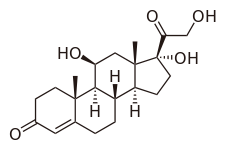Hydrocortisone
 |
|
 |
|
| Clinical data | |
|---|---|
| Trade names | Cortef, Solu-Cortef, others |
| AHFS/Drugs.com | Monograph |
| MedlinePlus | a682206 |
| License data |
|
| Pregnancy category |
|
| Routes of administration |
By mouth (tablets), intravenous, topical, rectal |
| ATC code | |
| Legal status | |
| Legal status | |
| Identifiers | |
|
|
| CAS Number | |
| PubChem CID | |
| DrugBank | |
| ChemSpider | |
| UNII | |
| KEGG | |
| ChEBI | |
| ChEMBL | |
| Chemical and physical data | |
| Formula | C21H30O5 |
| Molar mass | 362.460 g/mol |
| 3D model (Jmol) | |
|
|
|
|
|
|
|
Hydrocortisone, sold under the brandname Cortef among others, is the name for the hormone cortisol when supplied as a medication. Uses includes conditions such as adrenocortical insufficiency, adrenogenital syndrome, high blood calcium, thyroiditis, rheumatoid arthritis, dermatitis, asthma, and COPD. It is the treatment of choice for adrenocortical insufficiency. It can be given by mouth or by injection. After long-term use, if stopped this should be done slowly.
Side effects may include mood changes, increased risk of infection, and swelling. With long-term use common side effects include osteoporosis, upset stomach, physical weakness, easy bruising, and yeast infections. While used, it is unclear if it is safe during pregnancy. It works as an antiinflammatory and by immune suppression.
Hydrocortisone was discovered in 1955. It is on the World Health Organization's List of Essential Medicines, the most effective and safe medicines needed in a health system. It is available as a generic medication. The wholesale cost in the developing world is about 0.27 USD per day as of 2014 for the form taken by mouth. In the United States it costs less than 25 USD for a typical month of treatment.
...
Wikipedia
